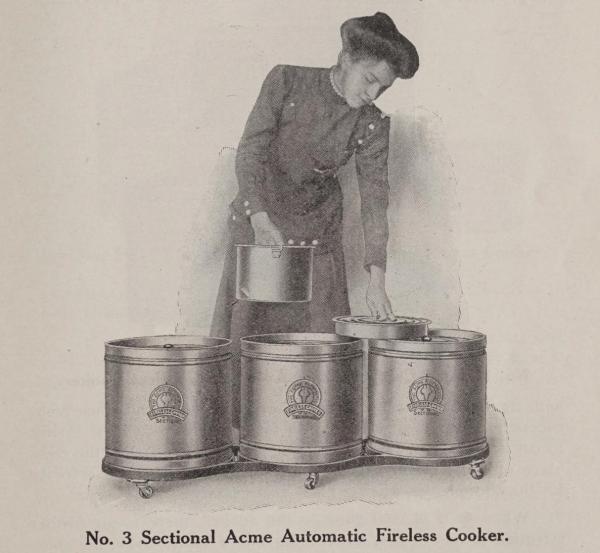
Acme Automatic Fireless Cooker, 1910. Book of Recipes for Acme Automatic Fireless Cooker. Quincy, IL: H.M. Sheer Company. Available at: https://archive.org/details/bookofrecipesfor00shee
There should be a fireless cooker in every kitchen in the land, because it does away with much of the drudgery which three meals a day three hundred and sixty-five days a year ordinarily entail. It is absolutely reliable. Think what it is to cook without having to stay in the kitchen to watch the food or to feed the fire. Food in a fireless cooker never burns nor dries up — it is sure to be done on time. A woman soon learns how much time the fireless cooker requires to cook given food. A fireless cooker is a faithful friend.
Frayser, Mary E. (1914). Fireless Cooking. Bulletin of the Winthrop Normal & Industrial College of South Carolina, Volume VII, Number 4, Part 2, p. 1. Available at: https://ttu-ir.tdl.org/handle/2346/45504.
While expediency is a factor often associated with a specific class of food (“convenience foods”) it has also been a long-standing consideration in all aspects of home food preparation, including kitchen design and actual cooking methods. The well-equipped kitchen of a century ago was envisioned in many home economics publications from the early twentieth century as a well-designed, pleasant place where all sorts of homemaking tasks could be performed efficiently and with minimum drudgery. At the beginning of the 1900s a specific cooking appliance gained prominence and was advocated by cookbook authors and U.S. Department of Agriculture home economists as a way to make delicious meals with minimum effort. This review will describe the development and rise of the fireless cooker, its status as a commercially marketed home kitchen appliance, and the fireless cooker's re-emergence within low-income countries.
Important Note: This review is meant as an overview of historical USDA publications and associated materials and should not be considered as a recommendation for the use of hayboxes or fireless cookers.
All food handling and cooking procedures should follow the guidelines listed in Basics for Handling Food Safely, issued by the U.S. Department of Agriculture's Food Safety and Inspection Service. Among other requirements are the following:
- Cook all raw beef, pork, lamb and veal steaks, chops, and roasts to a minimum internal temperature of 145 °F as measured with a food thermometer before removing meat from the heat source. Cook all poultry to an internal temperature of 165 °F as measured with a food thermometer.
- Hot food should be held at 140 °F or warmer.
- When serving food at a buffet, keep food hot with chafing dishes, slow cookers, and warming trays.
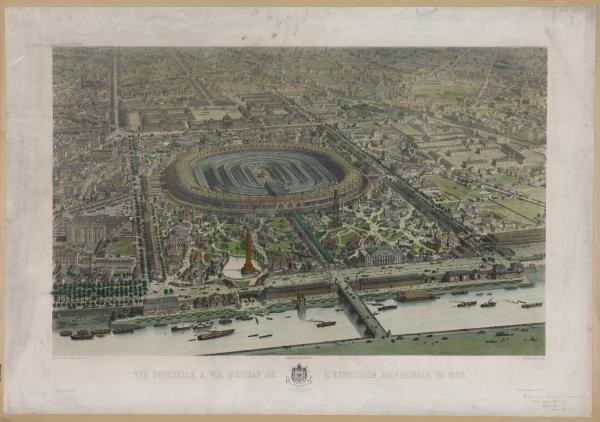
Vue officielle a vol d'oiseau de l'exposition universelle de 18 (Bird's-eye view of exposition grounds, Paris, France). Ciceri, Eugène, 1867. LC-DIG-pga-00497 Library of Congress Prints and Photographs Division. Available at: http://www.loc.gov/pictures/item/00652015/
Introduction of Fireless Cookers to American Cooks
One of the earliest mentions of the fireless cooker as a device suitable for the home cook came in the form of a newspaper account of the 1867 Paris Exhibition.
The Paris correspondent of the Times has lately called attention to an apparatus for cooking which he has seen in operation at the [Paris] Exhibition, and which really seems capable of bring about, not only a saving of the most valuable qualities of food, but also of fuel, water, time, and money. The invention is simplicity itself, and as we have personally examined and tested its powers, we are able to give a description of the modus operandi. We have first, then, a wooden box about eighteen inches square, and on raising the lid it is seen that there is a lining throughout of black felt (enclosing a thick padding,) leaving an aperture in the centre, which contains a round tin box. We were courteously asked to name some viand for illustrating the use of the apparatus; and having selected a promising-looking chicken from the nearest poulterer’s, it was placed in the tin box (which is really the cooking vessel, and has a lid like that of an ordinary saucepan,) a sufficient quantity of cold water was added to cover the chicken, potatoes and rice were put in, and the cooking vessel was then removed and placed on a common fire. As soon as the contents had been brought to a boiling point, the vessel was quickly removed from the fire and dropped into its nest in the box; a wad of black felt was placed over it, the box lid shut closely down, and the box carried away to that part of the room furthest from the fire. Two hours afterwards the box was opened, the wad removed the cover of the vessel raised, and a most appetizing odor gave promise which was amply borne out. The chicken had, in this automatic fashion, been cooked to perfection, and it was evident that the loss of flavor and delicacy by the ordinary process of boiling had been entirely done away with in the present instance. Potatoes and rice were equally satisfactory. p. 193
Richmond Medical Journal. March, 1868. Volume V, Number 1. p. 193-194. The Medical Heritage Library. Available at: https://archive.org/details/richmondmedicalj05rich.
Some further context was provided in a report from 1913 which also referenced another name for the cooker — the hay box, and a place of European origin — Norway.
The fireless cooker is, I believe, a Norwegian invention. It was first brought to the attention of the public at the Paris Exposition of 1867, where a wooden box lined with wool and felt was exhibited under the name of the ‘Norwegian automatic kitchen.’ Food boiled on a fire for a very few minutes continued to cook slowly when placed in this box, and after two or three hours was in excellent condition for the table….At the same time improvements were introduced; instead of being made entirely of wood, as at first, cork and hard paper were tried, and felt, feathers, and even hay were used for upholstering the boxes, which were often called ‘hay boxes’ or ‘hay cookers.’ p. 305
Osborne, John Ball (April 17, 1913). Market for fireless cookers in France. Daily Consular and Trade Reports, Number 89, 305-308. Bureau of Foreign and Domestic Commerce. U.S. Department of Commerce.
Traditional Fireless Cooking Methods
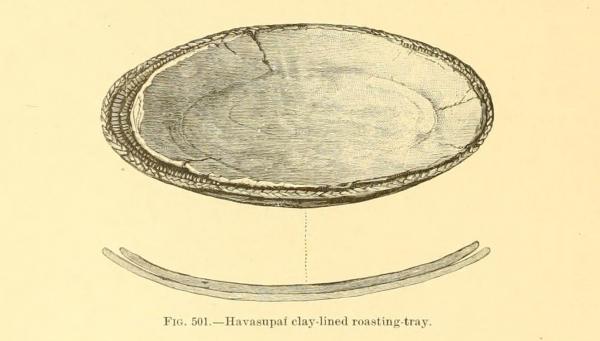
Havasupai Clay-Lined Roasting Tray from Cushing, F.H. (1883). A study of pueblo pottery as Illustrative of Zuñi culture-growth. Fourth Annual Report of the Bureau of Ethnology to the Secretary of the Smithsonian Institution 1882-1883. Smithsonian Institution. Bureau of Ethnology. J.W. Powell, Director, 473-521. Available at: https://archive.org/details/annualreportofbu418821883smit
Of course, the "fireless" method of cooking — application of initial heat to food and then its placement within some sort of protected, insulated environment for an extended period — did not make its first appearance at the Paris Exposition of 1867.
A 1886 Smithsonian Report documented cooking methods in long use by the indigenous peoples of North America. Frank Hamilton Cushing described the Havasupai Roasting Tray and the Havasupai Boiling-Basket of Cataract Canyon, Arizona.
They [the Havasupai or Cocouinos, of Cataract Canyon, Arizona] had not yet forgotten how to boil food in water-tight basketry, by means of hot stones, and continued to roast seeds, crickets, and bits of meat in wicker-trays, coated inside with gritty clay....A round basket-tray, either loosely or closely woven, is evenly coated inside with clay, into which has been kneaded a very large proportion of sand, to prevent contraction and consequent cracking from drying. This lining of clay is pressed, while still soft, into the basket as closely as possible with the hands and then allowed to dry. The tray is thus made ready for use. The seeds or other substances to be parched are placed inside of it, together with a quantity of glowing wood-coals. The operator, quickly squatting, grasps the tray at opposite edges, and, by a rapid spiral motion up and down, succeeds in keeping the coals and seeds constantly shifting places and turning over as they dance after one another around and around the tray, meanwhile blowing or puffing the embers with every breath to keep them free from ashes and glowing at their hottest. That this clay lining should grow hard from continual heating, and in some instances separate from its matrix of osiers, is apparent. The clay form thus detached would itself be a perfect roasting- vessel.
Among the Havasupai, still surviving as a sort of bucket, is the basket-pot or boiling-basket, for use with hot stones, which form I have also found in some of the cave deposits throughout the ancient Zuñi country. These vessels...were bottle shaped and provided near the rims of their rather narrow mouths with a sort of cord or straphandle, attached to two loops or eyes...woven into the basket, to facilitate handling when the vessel was filled with hot water. p. 484-485
Cushing, F.H. (1883). A study of pueblo pottery as Illustrative of Zuñi culture-growth. Fourth Annual Report of the Bureau of Ethnology to the Secretary of the Smithsonian Institution 1882-1883. Smithsonian Institution. Bureau of Ethnology. J.W. Powell, Director, 473-521. Available at: https://archive.org/details/annualreportofbu418821883smit.
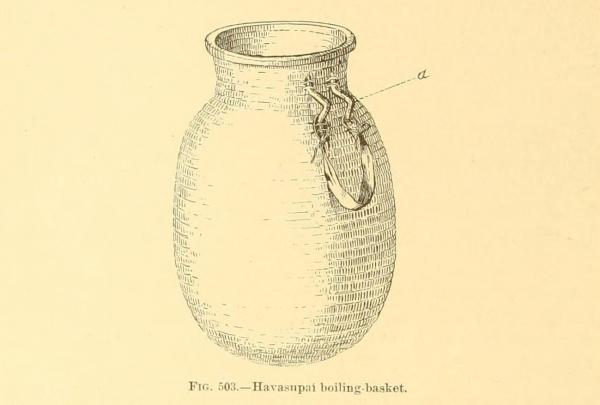
Havasupai Boiling-Basket
Walter Hough added to the Smithsonian's documentation of traditional cooking methods with his description of the ways that indigenous people in California cooked with hot stones and pit ovens.
The Pomos of California made a fire and put in stones to heat. When they were hot half of them were taken out and the remainder pushed together to form a layer, and were covered with a layer of oak and iris leaves. Acorn meal was then put on this layer, then a layer of leaves, and finally the remaining hot stones. Six inches of earth was piled on top and the heap was left to cook for six or eight hours.
The type of pit oven in which the heating medium is hot rocks has been observed in many parts of the world. Even the western Eskimo cook and render harmless the roots of the wild parsnip in an underground oven with hot stones....
Cooking by absorbed heat under conditions of good insulation is effected by the fireless cooker. With the adjuncts of heated irons or stones, the resemblance to the pit oven is apparent. The preservation of heat by insulation has long been known, and the efforts to prevent loss by radiation has occupied engineers and inventors and has produced a remarkable series of devices. The classical reference in Juvenal's satires to the custom of the Jews of keeping food warm over the Sabbath in baskets of hay suggests the hay cooker, which preceded the fireless cooker. p. 36-37; 44
Hough, W. (1926). Fire as an Agent in Human Culture. Smithsonian Institution. United States National Museum. Bulletin 139. Available at: https://doi.org/10.5479/si.03629236.139.i.
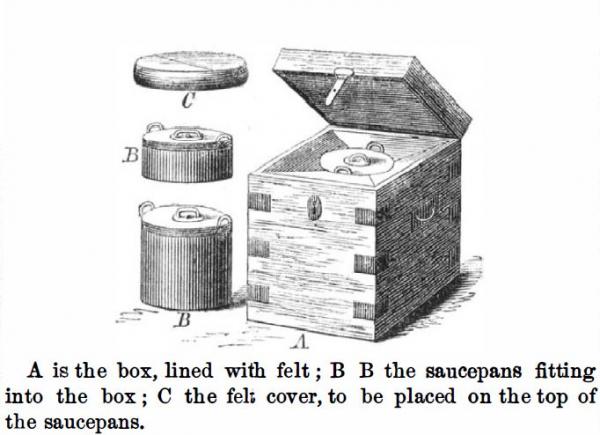
The Self-Acting Norwegian Cooking Apparatus. (September 11, 1869). Scientific American, Vol. 21(11), 161. Available at: https://www.jstor.org/stable/26034508.
The Self-Acting Norwegian Cooking Apparatus
A detailed drawing of and instructions for using the "Norwegian cooking apparatus" appeared in a Scientific American article from September 11, 1869.
The instructions were given as follows:
It is constructed in the most simple manner, of a wooden box lined with four inches of felt, in which the saucepans containing the food, previously boiled and maintained at the boiling point for five or ten minutes, according to the nature of the food to be cooked, are placed. The heated saucepans are covered with a thick felt cover, and, the lid of the box being fastened down, the rest of the cooking is done by slow digestion, no more heat being added.
The heated vessels containing the food will retain a high temperature for several hours, so that a dinner put into the apparatus at eight o’clock in the morning would be kept quite hot up to ten or twelve at night, because the felt clothing so completely prevents the escape of the heat; and as the whole is inclosed [sic] in a box, there are no currents of air to carry off any other heat by convection….
The principle on which this cooking apparatus acts is that of retaining the heat; and it consists of a heat-retainer or isolating apparatus, shaped somewhat like a refrigerator, and of one or more saucepans, or other cooking vessels, made to fit into it. Whereas, in the ordinary way of cooking, the fire is necessarily kept up during the whole of the time required for completing the cooking process, the same result is obtained, in using this apparatus, by simply giving the food a start of a few minutes’ boiling, the rest of the cooking being completed by itself in the heat-retainer away from the fire altogether. p. 161
Fireless Cookers and The U.S. Department of Agriculture
A flurry of publications authored by employees of the U.S. Department of Agriculture appeared in the 1910s describing the fireless cooker and advocating its use by the homemaker. Here is a sample:
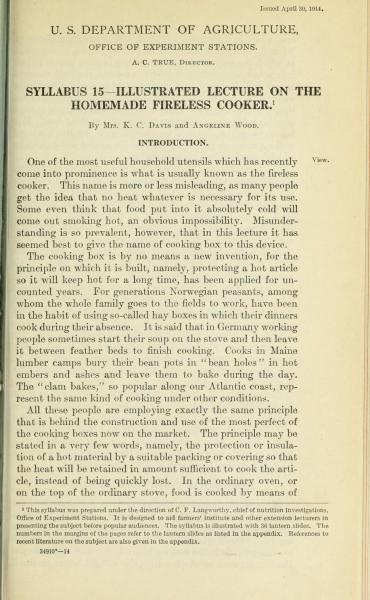
Davis, K.C. & Wood, A. (1914). Syllabus 15 — Illustrated Lecture on the Homemade Fireless Cooker. U.S. Department of Agriculture. Office of Experiment Stations. Available at: https://archive.org/details/syllabus15illust15davi
One of the most useful household utensils which has recently come into prominence is what is usually known as the fireless cooker. This name is more or less misleading, as many people get the idea that no heat whatever is necessary for its use. Some even think that food put into it absolutely cold will come out smoking hot, an obvious impossibility. Misunderstanding is so prevalent, however, that in this lecture it has seemed best to give the name of cooking box to this device.
The cooking box is by no means a new invention, for the principle on which it is built, namely, protecting a hot article so it will keep hot for a long time, has been applied for uncounted years. For generations Norwegian peasants, among whom the whole family goes to the fields to work, have been in the habit of using so-called hay boxes in which their dinners cook during their absence. It is said that in Germany working people sometimes start their soup on the stove and then leave it between feather beds to finish cooking. Cooks in Maine lumber camps bury their bean pots in ‘bean holes’ in hot embers and ashes and leave them to bake during the day. The ‘clam bakes,’ so popular along our Atlantic coast, represent the same kind of cooking under other conditions.
All these people are employing exactly the same principle that is behind the construction and use of the most perfect of the cooking boxes now on the market. The principle may be stated in a very few words, namely, the protection or insulation of a hot material by a suitable packing or covering so that the heat will be retained in amount sufficient to cook the article, instead of being quickly lost. In the ordinary oven, or on the top of the ordinary stove, food is cooked by means of heat which is continuously applied. If the cooking box is to be used, the food is heated on an ordinary stove, to the point at which the necessary cooking process begins; then it is put into a box so constructed that the heat in the food can not escape from it except very slowly, and the cooking continues without the use of more heat. Of course in the oven or on the stove top, the food reaches a higher temperature or is kept at a high temperature longer than in the cooking box. The latter, therefore, can not be so well used for the kinds of cooking in which prolonged high heat is needed as for those in which long slow cooking is desirable….
Since the power of holding food for a long time near the temperature at which it is put into the cooking box is the important feature of this device, evidently the best cooking box, other things being equal, will be the one from which heat is given off least rapidly.
The cooking box consists in its essentials of a receptacle for the hot food, and a container for this receptacle which is packed or otherwise insulated with suitable material, so that the heat will not escape, but the food will remain hot and continue to cook. Every woman who wraps up a hot soapstone or a bottle of hot water in a flannel, so that it may keep hot for a long time applies the principle of the fireless cooker.
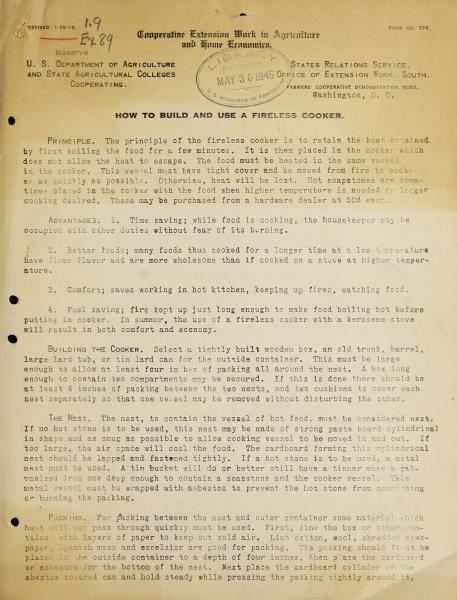
Creswell, M.E. and Powell, O. (1916). How to Build and Use a Fireless Cooker. U.S. Department of Agriculture. Office of Extension Work in the South. Available at: https://archive.org/details/CAT31306712
Principle.
The principle of the fireless cooker is to retain the heat obtained by first boiling the food for a few minutes. It is then placed in the cooker which does not allow the heat to escape. The food must be heated in the same vessel in the cooker. The vessel must have tight cover and be moved from fire to cooker as quickly as possible. Otherwise, heat will be lost. Hot soapstones are sometimes placed in the cooker with the food when higher temperature is needed or longer cooking desired. These may be purchased from a hardware dealer at 50 cents each.
Advantages.
- Time saving; while food is cooking, the housekeeper may be occupied, with other duties without fear of its burning.
- Better foods; many foods thus cooked for a longer time at a low temperature have finer flavor and are more wholesome than if cooked on a stove at higher temperature.
- Comfort; saves working in hot kitchen, keeping up fires, watching food.
- Fuel saving; fire kept up just long enough to make food boiling hot before putting in cooker. In summer, the use of a fireless cooker with a kerosene stove will result in both comfort and economy.
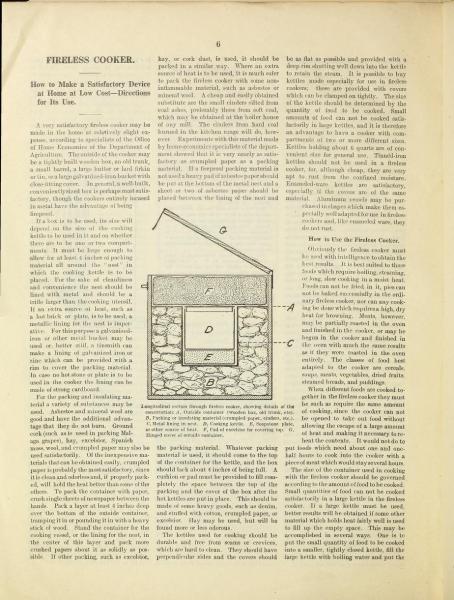
Fireless Cooker. How to Make a Satisfactory Device at Home at Low Cost — Directions for its Use. (1917). Food Thrift Series. U.S. Department of Agriculture, 6-7. Available at: https://archive.org/details/CAT10515717
Time Required for Cooking
The time which each kind of food should stay in the cooker depends both on the nature of the food and on the temperature at which it remains inside the cooker, and before recipes for use with the fireless cooker can be prepared one must have some means of knowing how temperatures are preserved in it. In experiments made in the Office of Home Economics a 6-quart kettle was filled with boiling water and put into the cooker, the packing of which happened to be newspaper. The temperature of the water, which was 212° F. when put into the cooker, was found to be 172° F. after four hours had elapsed and 155° F. after eight hours had elapsed. This shows the advisability of the common custom of allowing food to remain undisturbed in the cooker for at least six or eight hours, or in some cases overnight. If a soapstone, hot brick, or other extra source of heat is used, less time will be required. Materials which are denser than water (sugar sirup as used in cooking dried fruit), and therefore can be heated to a higher degree, will keep up the temperature longer when put into the cooker. Thus the density of the food material, as well as the amount and the length of time that the apparatus retains the heat, must be taken into consideration in determining how long different materials must be cooked in the cooker.
The recipes for dishes to be prepared in the fireless cooker differ somewhat from those for foods cooked in the ordinary way, chiefly in the amount of water or other liquids called for. Less liquid should be put into the food to be prepared in an ordinary fireless cooker, since there is no chance for water to evaporate. The cook must be guided largely by experience in deciding how long food should be heated before being put into the cooker and how long it should be allowed to remain there.
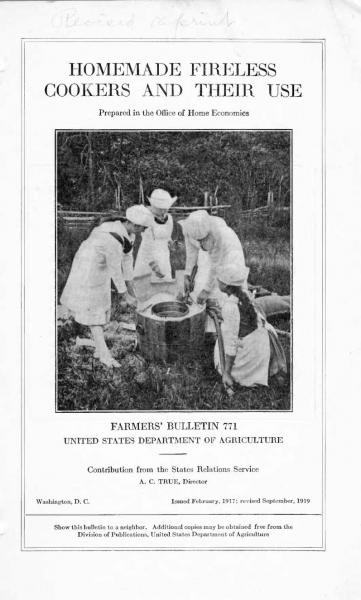
U.S. Department of Agriculture. Office of Home Economics. (1919). Homemade Fireless Cookers and Their Use. Farmers’ Bulletin, Number 771. Available at: https://archive.org/details/CAT31128016
In using a fireless cooker the food is first heated on the stove until the cooking has begun and then it is placed in the fireless cooker, a tight receptacle in which the food is completely surrounded by some insulating substance, which prevents the rapid escape of the heat so that it is retained in the food in sufficient quantity to complete the cooking. Sometimes an additional source of heat, such as a hot soapstone or brick, is put into the cooker with the food where a higher cooking temperature is desired. The same principle is also employed in other ways in cookery. For example, in camps beans are often baked by burying the pots over-night with hot stones and ashes, the whole being covered with earth, and in the ''clam bakes'' on the Atlantic coast the damp seaweed spread over the embers and the clams prevents the escape of the heat during cooking. The peasants in some parts of Europe are said to start their dinner cooking and then put it into hay boxes or between feather beds so that the cooking may be completed while the family is absent in the fields.
One of the chief advantages of the fireless cooker is that it accomplishes a saving in fuel, especially where gas, kerosene, or electric stoves are used. Where coal or wood is the fuel, the fire in the range is often kept up most of the day, and the saving in fuel is less. In summer or when the kitchen fire is not needed for heating purposes, the dinner can be started on the stove early in the morning and then placed in the fireless cooker, the fire in the range being allowed to go out. During hot weather the use of a kerosene or other liquid-fuel stove and a fireless cooker is a great convenience, since it not only accomplishes a saving in fuel but helps to keep the kitchen cooler. As would be expected, the saving in fuel resulting from the use of a fireless cooker is greatest in the preparation of foods like stews, which require long and slow cooking.
The great convenience of the fireless cooker is that it saves time, for foods cooked in it do not require watching and may be left to themselves while the cook is occupied with other duties, or the family is away from home, without danger from fires or overcooking the food. Another advantage in the use of the fireless cooker is that it makes it easier to utilize cheaper cuts of meats, which, although not having as fine a texture or flavor, are fully as nutritious, pound for pound, as the more expensive cuts. Long cooking at relatively low temperature, such as is given foods in the fireless cooker, improves their texture and flavor. p. 3-4
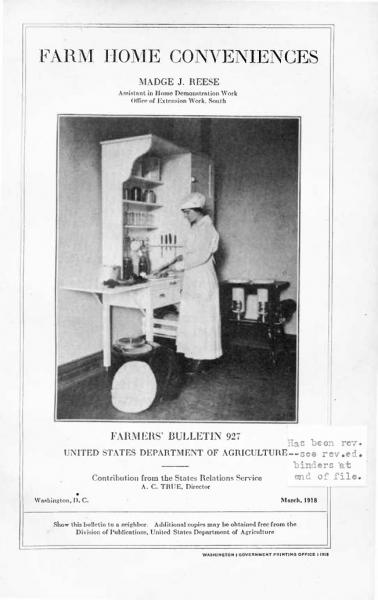
Reese, M.J. (1918). Farm Home Conveniences. Farmers’ Bulletin, Number 927. Available at: https://archive.org/details/CAT87202548
Fireless cookers are now being made and used in hundreds of country homes. What is more pleasing to the farm woman than to put her dinner in the fireless cooker before she drives to town to market her products, and upon returning find it is ready for serving?
The fireless cooker offers several advantages. The first is economy of time, as the housekeeper may leave the food cooking without worrying about the results while she is engaged in other household duties or visiting her friends.
Some foods are improved by long cooking at relatively low temperature. The texture and flavor of tougher cuts of meat, old, tough fowl, and ham are improved by slow cooking. Cereals, dried legumes, and dried fruits are more palatable and wholesome when cooked for a long time. Soups and stews are delicious when cooked in the cooker. Baking, however, cannot be done very conveniently and satisfactorily in the ordinary homemade fireless cooker.
In some sections of the country economy of fuel must be an important consideration. The food for the cooker may be started on the wood or coal range when the morning meal is being prepared. In warm weather the use of a fireless cooker and a kerosene stove means not only economy of fuel, but also comfort.
The food to be cooked is first heated to boiling point on the stove in the cooking vessel and then this vessel, covered with a tight lid, is quickly placed in the cooker, where the cooking continues. The cooker is so constructed that the heat does not escape. For long cooking it is necessary to place in the cooker under the cooking vessel a hot radiator. A soapstone is the best radiator and can be purchased at most hardware stores for 50 cents. A stove lid, a brick or disk made of concrete, heated and placed in the cooker, may serve as the radiator.
The Fireless Cooker and World War I
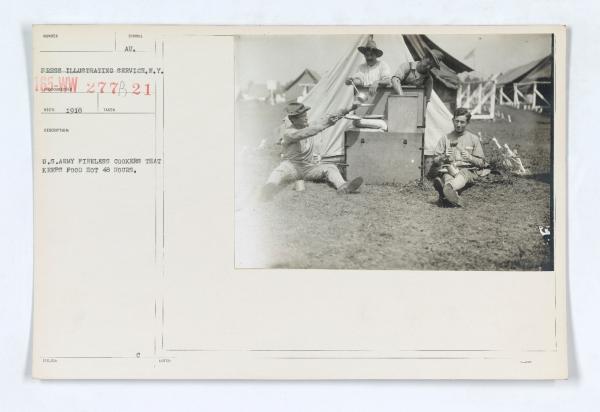
U.S. Army Fireless Cooker That Keeps Food Hot 48 Hours. 1918. 165-WW-277B-21 U.S. National Archives and Records Administration. Available at: https://catalog.archives.gov/id/45501022
The fireless method of cooking made a significant appearance in the ranks of the American military during the early years of the twentieth century and the First World War era. These publications explained its value in caring for the troops.
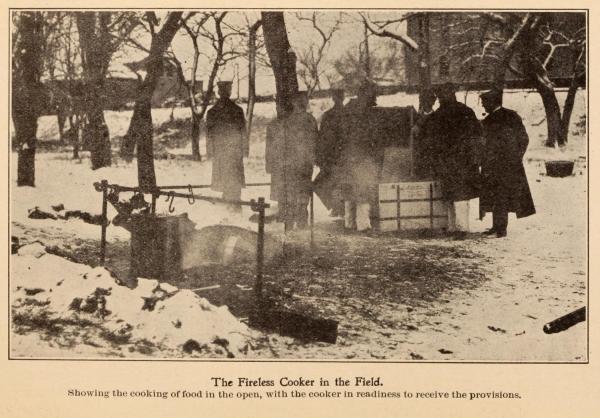
Cooking without fire. (1906). Journal of the Association of Military Surgeons of the United States. Volume XVIII. Number 6. 449-455. Available at: https://archive.org/details/journalofassocia1819asso
When an army is in the field, camping perhaps for the night or resting on their arms in trenches, in the presence of the enemy, it is out of the question to establish elaborate cooking facilities. It is often impossible to maintain fires over which to cook the soldier's repast. Under the new system all this can be avoided by starting out in the morning with food that has been placed on or in the cooking range at some convenient place of culinary operations. When meats, vegetables and coffee, for instance, have been cooked thirty minutes over a range or in the oven, they are placed in the fireless cooker, locked in, and this receptacle, containing enough food for the company at noon or at night, is packed on the Army wagons with the tentage, and follows the troops to the bivouac. There all that will be necessary will be the opening of the cooker and the removal of the articles of food. After a period of six or seven hours the meats and vegetables and the drinkables will be found to be fully cooked and palatable; roast beef will be at a temperature of 160 degrees, a ham will be hot at a temperature of 164 degrees, the vegetables will have a temperature of 140 degrees; coffee seems to get hotter than anything else and has a temperature of 172 degrees after its period of imprisonment. In the Army tests two chickens, officially described as old and tough, were converted into something tender and appetizing by this process. p. 449-450
U.S. War Department. (1917). Manual for Army Cooks, 1916. Available at: https://archive.org/details/manualforarmycoo1917unit(link is external).
A fireless cooker is an air-tight receptacle for the slow preparation of partly cooked food by heat stored up in the food, or mechanically introduced as when soapstones are used. It is also used to preserve the temperature of food cooked or uncooked.
It is generally a box-like arrangement lined with a nonconducting material within which is the well or reservoir, into which the vessel containing the hot food is placed.
Many different makes of fireless cookers are found on the market, and various material such as asbestos, paper felt, hay, indurated fiber, etc., are used as nonconductors. In some types heated soapstones are placed in the well to keep the food at a cooking temperature for long periods, or to supply the heat ordinarily given to the food before it is placed in the cooker…. The advantages are: The food may be served warm on the march or upon arrival in camp; it saves fuel; being a slow process it renders such food as tough meats tender and palatable; and the food, having been placed in the cooker, requires no further attention. p. 123
Andrews, L.C. and Wood, L. (1916). Fundamentals of Military Service. Philadelphia: J.B. Lippincott Company. Available at: https://archive.org/details/fundamentalsmil00andrgoog(link is external).
Arrangements should be made so that when on the march men may be given their mid-day meal almost immediately after reaching camp, and the most helpful auxiliary to this is the fireless cooker. One of these can be easily made from a good-sized dry goods box, padded with hay held in place by old saddle blankets, leaving room for two large milk cans that will carry enough food and coffee for the command. The cooks will fill these with boiling hot contents after supper the night before, put them in the box, stuffing hay in about them, and close it; this box will be loaded at the rear end of the wagon, and a hot meal may be served the instant the wagon arrives in camp. Many troops in the regular service take a light spring wagon with them in the field, which carries the fireless cooker, picket line, and other small conveniences, and reaches camp ahead of the command. When the troop arrives the picket line is ready to be stretched and the lunch ready to be served. This adds tremendously to the comfort of the men and the esprit of the organization. p. 365-366
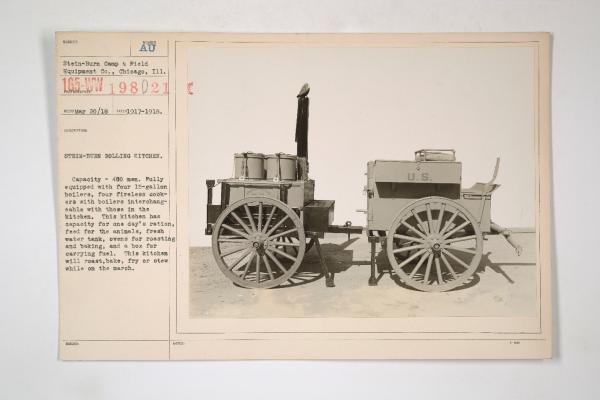
Stein-Burn Rolling Kitchen. Capacity-460 men. Fully equipped with four 15-gallon boilers, four fireless cookers with boilers interchangeable with those in the kitchen. This kitchen has capacity for one day's ration, feed for the animals, fresh water tank, ovens for roasting and baking, and a box for carrying fuel. This kitchen will roast, bake, fry or stew while on the march. Stein-Burn Camp & Field Equipment Co., Chicago, Ill. 1917-1918.
U.S. National Archives and Records Administration. 165-WW-198D-21
Available at: https://catalog.archives.gov/id/31488261
The Fireless Cooker Enters the Marketplace
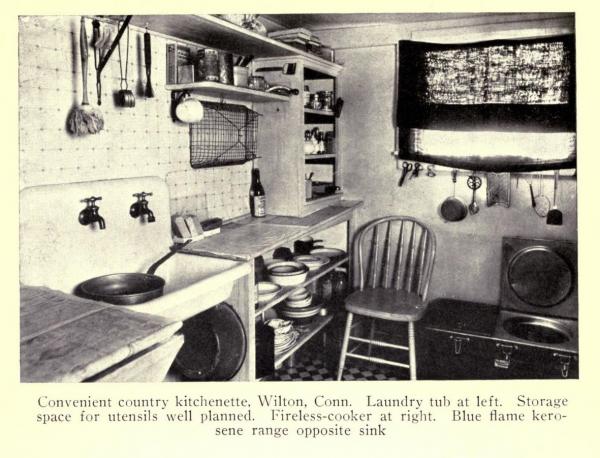
Child, G.B. (1914). The Efficient Kitchen: Definite Directions for the Planning, Arranging and Equipping of the Modern Labor-Saving Kitchen. A Practical Book for the Home-Maker. New York: McBride, Nast & Company. Available at: https://archive.org/details/efficientkitch00chilrich
In America, [fireless cookers] were often called ‘hayboxes,’ because that’s what the old-fashioned version was: a wooden box stuffed full of hay in such a way that there was a space for the pot in the middle, and a pillow of cotton ticking, stuffed with more hay, that went over the top. A hundred years ago you could get elegant models from department stores that had porcelain-coated steel cases, rock wool insulation, and easy-to-clean metal liners with pots sized to fit; the best models had soapstone disks you could stick in the oven during the day’s baking, then drop into the fireless cooker, put a pot of soup or stew on top, and have it piping hot for dinner six hours later. p. 137
Greer, J.M. (2013). Green Wizardry: Conservation, Solar Power, Organic Gardening, and Other Hands-On Skills From the Appropriate Tech Toolkit. British Columbia, Canada: New Society Publishers.
As the fireless cooker advanced and became more sophisticated than the standard "wooden box stuffed full of hay," kitchen appliance companies such as the Chambers Manufacturing Company began to manufacture and market them to the homemaker. The models became progressively more elaborate and expensive.
Here is a sample of illustrations taken from company catalogs, advertisements, and home economics texts.
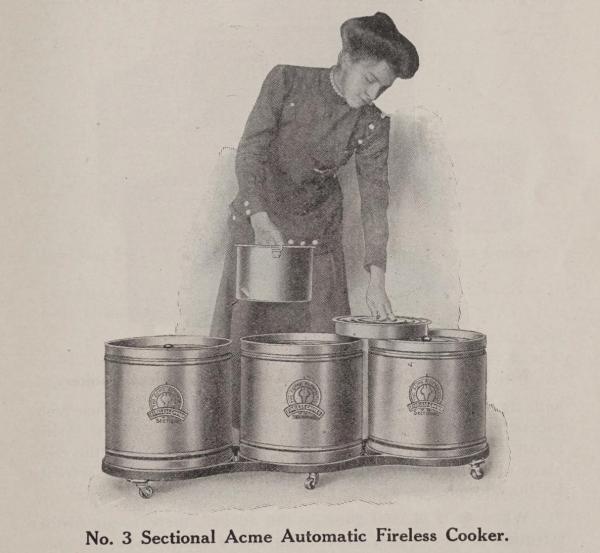
Acme Automatic Fireless Cooker, 1910. Book of Recipes for Acme Automatic Fireless Cooker. Quincy, IL: H.M. Sheer Company. Available at: https://archive.org/details/bookofrecipesfor00shee
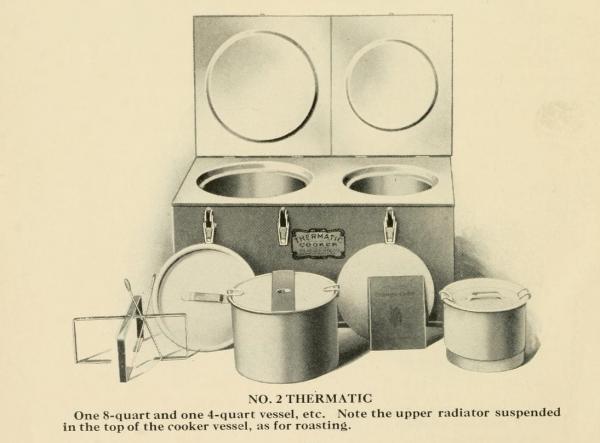
Thermatic Fireless Cooker, 1911. Triplett, R.L. A Treatise on the Management of the Thermatic Fireless Cooker, Together with Over 250 Carefully Selected Recipes. Bluffton, OH: Diller Manufacturing Company. Available at: https://archive.org/details/treatiseonmanage00trip
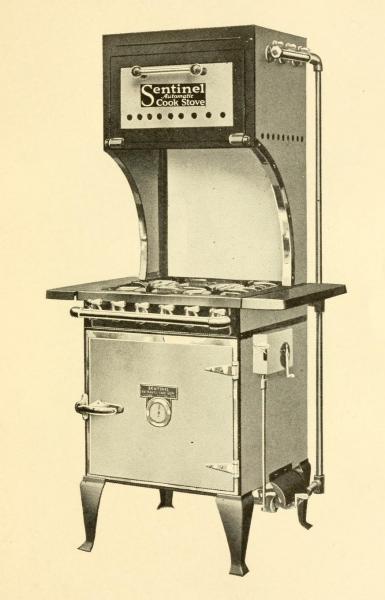
Sentinel Automatic Cook Stove: Metropolitan Model, 1915. Frederick, C. Meals that Cook Themselves and Cut the Costs. New Haven, CT: Sentinel Manufacturing Co. Available at: https://archive.org/details/mealsthatcookthe00fred
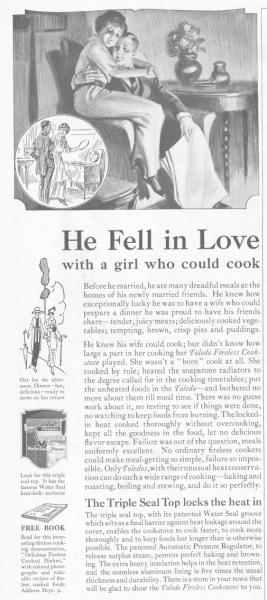
Toledo Fireless Cookstove Advertisement, July 1920. Ladies’ Home Journal. Volume 27, 106. Available at: https://babel.hathitrust.org/cgi/imgsrv/download/pdf?id=mdp.39015014704319;orient=0;size=100;seq=1366;attachment=0
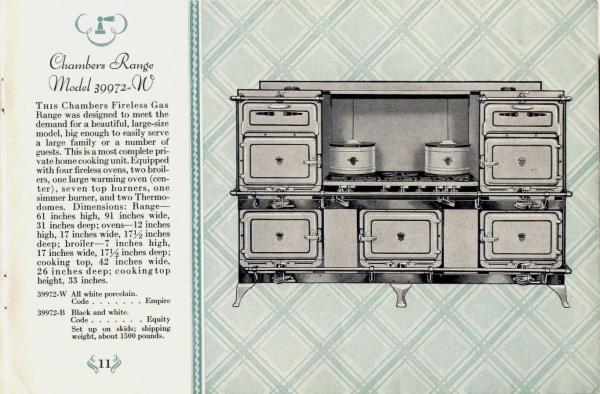
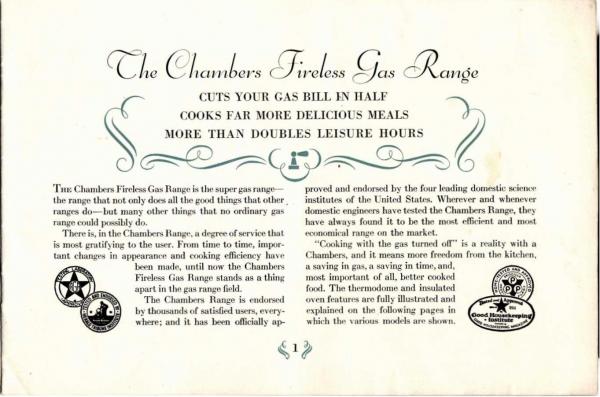
Chambers Manufacturing Company. (Undated, Late 1920s). The Chambers Fireless Gas Range. Available at: https://archive.org/stream/1927IdleHourCookbookFromDwayner/Chambers Catalog - Late 1920s#mode/
The Demise of the Fireless Cooker
As modern stoves and electrical cooking appliances came into use, fewer and fewer cooks continued to use fireless cookers. Advertisements for commercial cookers disappeared from newspapers, and directions for using them disappeared from recipe books.
Mooney-Getoff, M. (2004). “Fireless Cookers.” The Oxford Encyclopedia of Food and Drink in America, Second edition. Volume 1. Edited by Andrew Smith. p. 762-763. Oxford University Press
In a way, the demise of the fireless cooker for everyday use in the middle-class kitchen was rooted in its very beginnings. When it first appeared in the marketplace it was oversold by many kitchen equipment manufacturers and home economists alike as the ultimate answer to every homemaker's struggle with cooking: including finding enough time, energy, planning, and expertise. Although the fireless cooker offered a real convenience — cooking food without a need for constant attention at the stove or oven — it still required quite a bit of planning, skill, and work, just like the modern slow cooker. The following commentators point out many of the limitations and problems of this particular appliance.
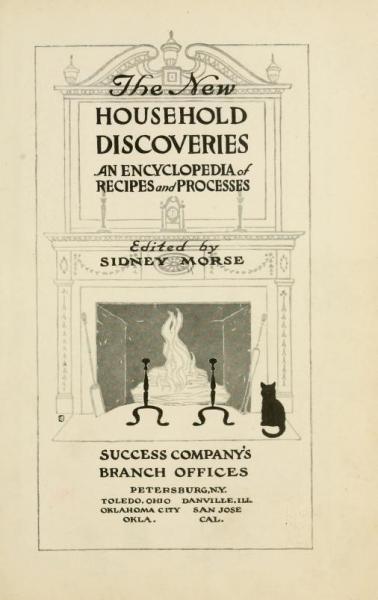
Morse, S.L. (1917). The New Household Discoveries: An Encyclopedia of Recipes and Processes. Petersburg, NY: Success Company's Branch Offices. Available at: https://archive.org/details/newhouseholddisc00mors
The term ‘Fireless Cooker’ is really a misnomer and it is very unfortunate that it has become attached to a device in which cookery is done by the process of retaining heat, once stored. The so-called Fireless Cooker as it exists today is an application of the old Norwegian cooking box, which is often referred to in our books of Physics as one of the best illustrations of the use of non-conductive material in retaining heat. The fireless cooker is not a miracle working cookery machine; and it has been handicapped from the start, not only by its misnomer, but by the extravagant claims that have been made for it by its admirers and promoters. Intelligently used it is a highly desirable addition to the kitchen equipment, but it can never entirely supersede the cooking stove, nor is it by any means the most desirable method of carrying on all cookery processes. It will always be necessary for the housewife to employ some sort of a cook stove on which to start the cooking of the food material, but the process may then be finished, if desired, in the fireless cooker.
This device, as was previously stated, is only a means for retaining heat previously applied. The chief essential of its construction, therefore, is that it shall be well insulated, that is thoroughly padded with non-conducting material so that hot things introduced into it shall remain hot, and cold things remain cold. The principle, in short, is the same as that of the Thermos bottle. p. 537
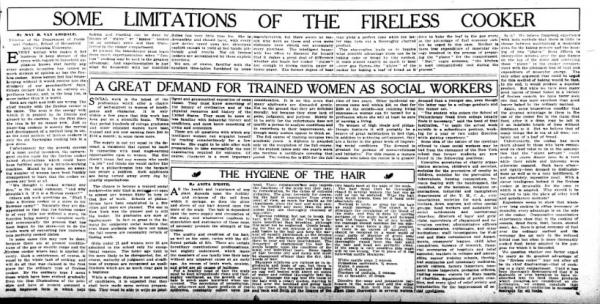
Van Arsdale, M.B. (23 Feb. 1913). “Some limitations of the fireless cooker.” The Washington Herald. (Washington, D.C.). Chronicling America: Historic American Newspapers. Library of Congress, 31 Available at: https://chroniclingamerica.loc.gov/lccn/sn83045433/1913-02-23/ed-1/seq-31/
Every woman who makes it her business to keep abreast of the times with regard to household appliances knows that hardly any other modern invention has caused so much division of opinion as has the fireless cooker. Some women feel that housekeeping without it would resolve into the drudgery of our grandmothers’ days. Others declare that it is an entirely superfluous luxury, and, in the long run, is more bother than it is worth.
Both are right and both are wrong. The chief trouble with the fireless cooker is its name. The next is the energy with which it is praised by its friends and abused by its enemies. In the first place the idea is by no means new. Just as paper-bag cookery is merely the revival and development of a method long in use, so the most modern of fireless cookers is only the old Norwegian cooking box in a new dress.
Unfortunately for the general success of a most useful invention, the extravagant claims made for the fireless cooker raised expectations which could have been fulfilled only by a miracle-working machine. Misled by its name, an amazing number of women have been frankly disappointed to learn that the cooker requires any heat at all.
‘We thought it cooked without any fire,’ is the usual comment, ‘and why shouldn’t it if it is a fireless cooker?’
…Unfortunately, the cooker has been much abused by those who have considered its chief value to lie in the assumption that the ‘silent servant’ could evolve a course dinner done to a turn while their minds and interests were otherwise engaged. Such have often—and rightly—been doomed to disillusionment as well as to a very indifferent, if not absolutely, impossible meal. With a clever intelligence behind it the fireless cooker is invaluable for the uses to which it is adapted. Why should it be required to that the place of other tried and satisfactory methods?’
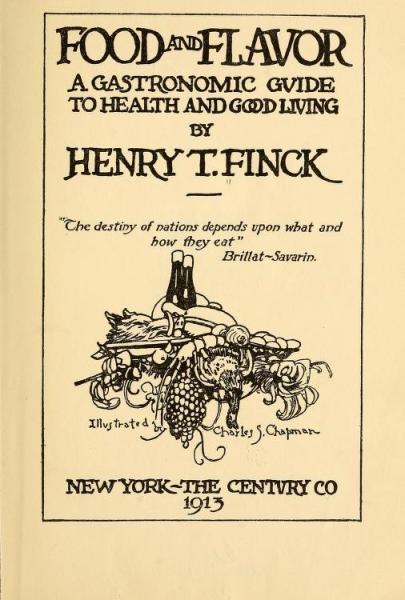
Finck, H.T. (1913). Food and Flavor: A Gastronomic Guide to Health and Good Living. New York: The Century Company. Available at: https://archive.org/details/foodflavorgastro00finc
Nor will the presence of a cooker make it any the less necessary for the mistress or the professional cook to thoroughly understand the culinary art. They must know about meats, and cereals, and vegetables, and flavors, and their combinations and extension, to which attention has been called. It is simply, in all households, valuable because it preserves flavors, eliminates the danger of burning or overcooking, reduces the cost of fuel by three-fourths or more, makes it easier to wash the pots and in other ways saves no end of drudgery; while for those who have to do their own cooking its advantages in giving leisure for other work, or diversions while the cooking goes on, are incalculable. p. 196
The Fireless Cooker's Re-Emergence in Low-Income Countries
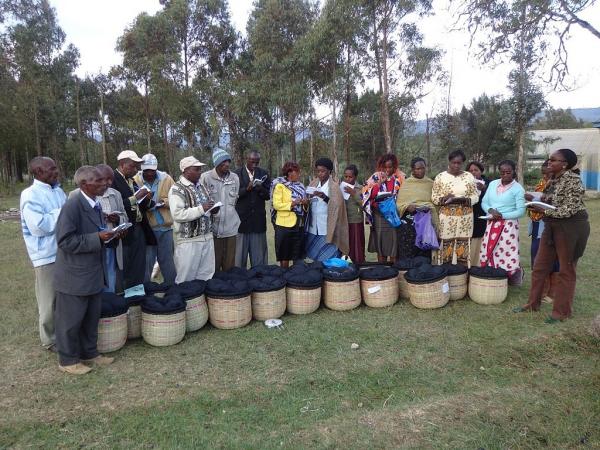
A Community Group Displaying Finalized Fire-Less Cooker Bucket They Made During a Training on How to Make Them (2014) by Synjagu is used under the Creative Commons Attribution-Share Alike 4.0 International License(link is external) (CC BY-SA 4.0). Available at: https://commons.wikimedia.org/wiki/File:Display_of_fireless_Cookstoves.jpg
A fireless cooker is an insulated container capable of maintaining a temperature at which food can be cooked. The practical fireless cooker is helping families in Kenya to escape the vicious cycle of poverty that is perpetuated by the sheer struggle to survive.
By making families less dependent on fuel, they no longer have to make the heartbreaking choices between sending their children to school and short-term survival, or going to work and collecting wood.
The 'fireless cooker' uses stored heat to cook food over a long period of time. The food is cooked on a traditional stove, before it's transferred to the fireless cooker. The cooker is well insulated, keeping the heat in the food and allowing it to continue cooking inside.
A simple basket, insulated with local resources such as banana leaves or old clothes, can reduce fuel use by 40%, preserving scarce food and saving people hours of precious time. p. 33
Geoffery, E.O. (2016). Report on Industrial Attachment held at the Kenya Forest Service. Ngong Road Forest. Nairobi Forest Conservancy Headquarters. University of Nairobi.
The fireless cooker has been reimagined as an insulated box or basket and a free-standing fabric bag as a way for low-income families to cook hot and nutritous meals that use less fuel, are less dependent on expensive kitchen cooking equipment, and produce less indoor pollution.
These current-day, scholarly journal articles and reports describe some of the benefits derived from this cooking tool.
(Note: No endorsement of the Wonderbag fireless cooker, the Kenya Ceramic Jiko or any other commercial product mentioned in this piece should be inferred.)
The fireless cooker is a little-used but valuable technology, comprising an insulated basket into which pre-heated food is left to cook in its own heat. During the recent Practical Action smoke alleviation project, the first fireless cooker demonstration used very smart baskets and expensive foodstuffs. The women felt it was ‘too expensive’ for them. In later demonstrations the project team discussed why the ‘fireless’ cooked the food, and women made their own baskets with local materials, thus empowering them to become the technologists. It provided a way of using the trusty open fire whilst still alleviating smoke and saving fuel. These fireless cookers provided an entry point for other, more expensive, smoke alleviation technologies. Laboratories cannot answer the questions that are closest to hearts and hearths of the cooks as they do not address the user’s lifestyle. The success of the fireless cooker is based on the concept of the ‘need for insulation’ as a technology, not on affordability of a technology. Their success in low income communities is evidence that women have been able to take up the technologies, but under their own terms and conditions. p. 12
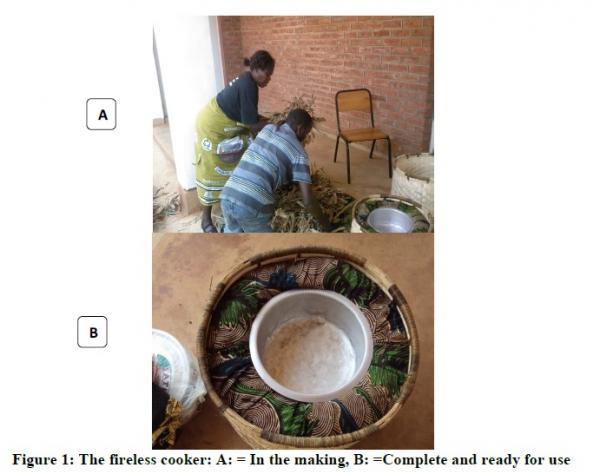
Sainan, H. & Kapute, F. (2017). Effect of cooking method on proximate and mineral composition of Lake Malawi tilapia (Oreochromis karongae). African Journal of Food, Agriculture, Nutrition and Development, 17 (4), 12589-12599. Available at: https://www.ajol.info/index.php/ajfand/article/view/163640
The fireless cooker is a simple insulated container (available in many designs) that uses the heat of the food being cooked to complete the cooking process. In fireless cooking, food is heated to the boiling point and then insulated. The fireless cooker normally requires up to twice as much time to cook food than the normal stovetop cooking time. This simple and local innovation has many advantages such as preventing heat from escaping into the environment; hence no additional energy is needed to complete the cooking process. The food can be left in the cooker until it is ready to serve and will keep hot for hours. Also, foods which require long cooking can be prepared in the fireless cooker. Use of the fireless cooker could save fuel to the extent of one third of the total consumption by avoiding the need for reheating, which may save between 20 to 80% of the total energy. The decrease in wood burning limits contact with smoke, and is environmentally friendly. p. 12592
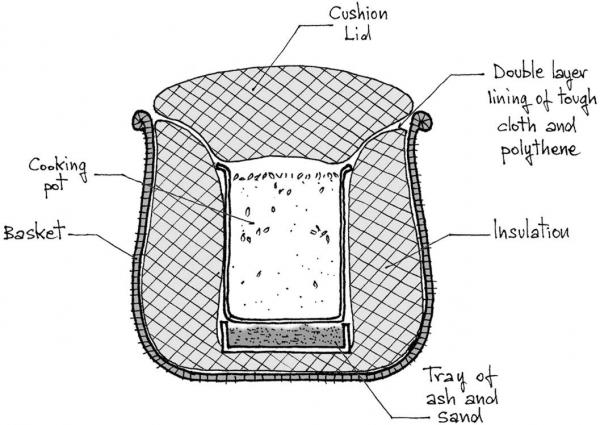
Barbieri, J., Riva, F., & Colombo, E. (2017). Cooking in refugee camps and informal settlements: A review of available technologies and impacts on the socio-economic and environmental perspective. Sustainable Energy Technologies and Assessments, 22, 194-207. Available at: https://doi.org/10.1016/j.seta.2017.02.007
A hay box (or fireless cooker/straw box/insulation cookers/retained-heat cookers) is an insulated container where a partially cooked food can be stored in order to continue cooking with no need to consume further fuel or external heat.... In such contexts with limited access to fuels, particularly for food requiring a long cooking time (i.e. legumes and rice), food can be initially brought to a boil with a traditional stove and then placed in a hay box to complete the cooking without burning any further fuel.... Therefore, instead of simmering it over fire, the food continues to cook over a longer period inside the fireless cooker, using its own stored energy and reducing the fuel use by even 40%.... As main drawbacks, the length of cooking time required in a hay box is higher compared with a traditional stove – food prepared in a hay box normally requires more than one to two times the normal cooking time..., and there is risk of bacteria growth if food remain too long at temperatures dropped below 60 °C.
They can be easily built starting from a basket, cloths and pillows, at zero or very low cost. Within humanitarian settings, The Vajra Foundation Holland...has been active in the Bhutanese refugee camps in Nepal since 1995 to bring both hay boxes and solar cookers to the refugees there. From 2001 to 2003 hundreds of hay boxes were distributed, covering the main sectors of Beldangi-I camp. After 2006, the Vajra Foundation Holland received nearly $1 million for their programme, and they disseminated 6300 solar cookers and 12,000 hay boxes to families in the camps as well as an extensive use and maintenance training. The UNHCR [The United Nations High Commissioner for Refugees] reports that a total of 3500 units of Save80 stoves and fireless cookers were distributed in 2010 in refugee camps in Chad, Djibouti, Ethiopia, Kenya, Rwanda, Sudan, Togo and Uganda. p 199-200
The Fireless Cooker in the present study was designed keeping in mind the Indian dietary pattern. It could be used suitably for cooking rice, dals, vegetables and other boiling purposes. The cooker with heat retention qualities has also an additional advantage of keeping the food within ‘safe limits’’, Longre’e (1980) suggests that the temperatures between 7° and 60° C are most favourable for microbial growth) and avoiding preheating of food at the time of serving. The fireless cooker also fulfilled the three basic selection criteria of any equipment viz. low in cost, ease in understanding the use and operation and ease in maintaining and storing the equipment. p. 99
Kaushik, V. (2010). Designing fireless cooker of indigenous insulation material for better heat retention. Journal of Human Ecology, 30(2), 99-104. Available at: https://www.tandfonline.com/doi/abs/10.1080/09709274.2010.11906278
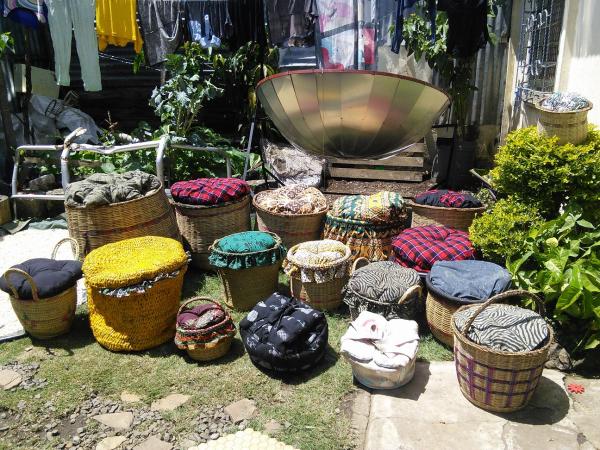
Diversity of fireless cookers, Kenya (2016) by Faustina Obada is used under the Creative Commons Attribution-Share Alike 3.0 Unported License(link is external) (CC BY-SA 3.0). Available at: https://energypedia.info/images/8/8f/Fireless_Cooker_Faustina_Obada.jpg
Retention Heat Cookers (RHC), such as a WonderBag, is a promising solution to increase the cooking energy efficiency which employs the retained heat for cooking in a rural kitchen or elsewhere. All sort of food items may be cooked in WonderBags, including rice, potato, chicken, vegetables, and beef etc. which are cooked with water. When the food is heated to its boiling temperature on the cooking stove, the food can be continued to be cooked using WonderBag by retaining the heat. This option offers several benefits including reduction of fuel usage, reduction of greenhouse gas emission, energy savings for cooking leading to monetary savings, indoor air pollution reduction etc.
Sadrul Islam, A.K.M. & Salehin, S. (2014). Performance Test of Wonder Bag: A Pathway to Reduce Cooking Energy Consumption and CO2 Emission. Bangladesh: Department of Mechanical and Chemical Engineering. Islamic University of Technology (IUT). Organisation of Islamic Cooperation (OIC) Board Bazar.
WonderBag is a Wonder heat retention cooker. It saves cooking time and fuel. This study aims to assess that ‘Whether WonderBag cooking technique does have any effect on Nutrient Quality and Shelf Life Stability of food’? To address this issue, three food items- Rice, Mixed vegetables and Chicken, most common food items frequently consumed by mass people, were selected to cook with WonderBag and gas stove cooking techniques. After completion of cooking, samples were collected from each of the cook foods as per predesigned sampling time schedule and procedure. Nutrient composition was analyzed with standard and validated analytical methods. Shelf life stability was assessed by evaluation of physical characteristics, and by analysis of microbial loads at different time intervals over a period of 12 hours after cooking the foods. Cook food items were also served to the research team members, lab staff and GIZ advisor to taste its palatability and deliciousness. Statistical analysis was employed to calculate mean and standard deviation. Independent t-test was performed to observe variation (if any) of nutrient constituents in the WonderBag foods as compared to the gas cook food items. Linear regression analysis was also done to find correlation of microbial loads with time elapsed and natural temperature fall.
Finding shows [sic] that nutrient composition of WonderBag food remains same and microbial growth is extremely low. Man time use is noted to be less of around 31 to 61 percent in the WonderBag cooking technique. Further, WonderBag food is comparatively delicious.
It is evident that WonderBag cooking do [sic] retains Nutrient Quality and significantly extend Shelf Life Stability of foods. p. 2
Nazrul Islam, S., Huque, S., and Islam Khan, N. (2014). Nutrient Quality of WonderBag Cooking: Nutrient Quality and Shelf Life Stability of WonderBag Food. Bangladesh: Institute of Nutrition and Food Science. University of Dhaka.
In Kenya, about 85 per cent of households in urban areas use the improved Kenya Ceramic Jiko [KCJ] stove, which has an energy conversion efficiency of about 33–35 per cent compared to 10–15 per cent obtained in traditional stoves. Use of the Kenya Ceramic Jiko enables poor urban households to make financial savings of 26 per cent of annual household income. Another type of stove that could contribute to a reduction in the quantity of charcoal used is the fireless insulation-based cooker. A fireless cooker completes cooking that is initiated by another stove such as the KCJ. Tests have shown that this cooker despite cooking food for a long time can reduce cooking energy consumption by 50 per cent. This suggests that a combination of ceramic stove and fireless cooker can reduce household charcoal consumption by 75 per cent (Mugo et al. 2007). Fireless cookers are made from a simple basket, insulated with local resources such as banana leaves or old clothes. Use of improved stoves could reduce the negative health effects of using of charcoal, where for example respiratory infections in children and women fell by 60 per cent and 65 per cent respectively when the KCJ was used. p. 364-365
Njenga, M., Karanja, N., Munster, C., Iiyama, M., Neufeldt, H., Kithinji, J. & Jamnadass, R. (2013) Charcoal production and strategies to enhance its sustainability in Kenya. Development in Practice, 23(3), 359-371. Available at: https://doi.org/10.1080/09614524.2013.780529(link is external).
During an interview with a West Kochieng citizen who has established a relatively profitable enterprise in Upesi stove and fireless cooker sales, she indicated that awareness of the dangers of kitchen smoke altered her perception of the risks several years ago and consequently led her to adopt the Upesi stove [a ceramic stove], fireless cooker and eaves spaces in her outdoor kitchen….
‘Awareness is what has increased. Because people now are actually realising. First of all there isn't much money. Secondly there is isn't much firewood. So now is when people are realising that this thing is able to save them, because it costs less and it uses less firewood. And they have seen people around them using it, and it is now real to them that it can save cost.’ (Interview West Kochieng Citizen 1). p. 207
Sesan, T. (2012). Navigating the limitations of energy poverty: Lessons from the promotion of improved cooking technologies in Kenya. Energy Policy, 47, 202-210.
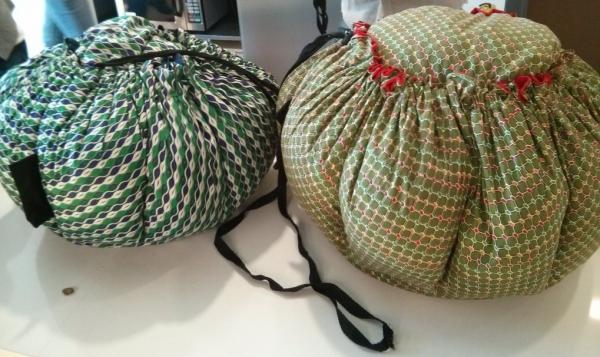
Wonderbag (modified) (2013) by Fumi Yamazaki(link is external) is used under the Creative Commons Attribution-NonCommercial-ShareAlike 2.0 Generic License(link is external) (CC BY-NC-SA 2.0). Available at: https://www.flickr.com/photos/fumi/11113304465/in/album-72157638169648476/
Finally, this video has no dialog or narration, but shows how food emerges from a fireless cooker hot and ready to eat after the cooking process has been completed properly. This video shows Faustine Odaba of the Natural Resources and Waste Management Alliance presenting the fireless cooker in Kampala, Uganda, 2017.
Video with captions: https://www.youtube.com/watch?v=NySEH2sXgJA&feature=emb_imp_woyt
Original video without captions is available from Bernhard Müller at: https://www.youtube.com/watch?v=UACXAsyvcR4
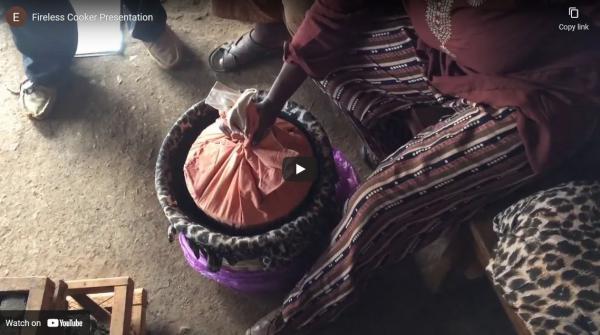
 An official website of the United States government.
An official website of the United States government.